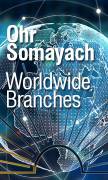Pinchas: An Asinine Essay (Part 2/2)
In Part I, we discussed the words chamor (domesticated donkey), pere (wild ass), and aton (a female donkey). In this installation, we continue the discussion to treat additional words related to donkeys, namely ayir, pered, and yeimim. Last week’s essay opened with a tie-in to Parashat Balak because Balaam rode an aton. This week’s Parashat Pinchas discusses the preparations for the war against Midian, and although this week’s Parashah does not go into detail about that war, the Torah later states that the Jews captured sixty-one thousand donkeys as part of the spoils of war (Num. 31:34) — so donkeys are also related to this week’s Parashah, as well.
The word ayir appears eight times in the Bible. For example, it is included among the animals that Jacob sent Esau as part of his tribute (Gen. 32:16). Likewise, the judge Jair the Gileadite was said to have sired thirty sons who rode thirty ayarim (Jud. 10:4), while the judge Ivtzan was said to have fathered forty sons and thirty grandsons who rode on seventy ayarim (Jud. 12:14). Evidently, riding an ayir in ancient times was a sign of nobility, and the prophet Zechariah famously referred to the Messiah as “riding on a chamor and an ayir son of atonim” (Zech. 9:9).
As seen from this last passage and several others that juxtapose the term ayir to aton, it is clear that in Biblical Hebrew, the ayir is the aton’s offspring (e.g., see Gen. 32:16, 49:11, Zech. 9:9), making it a “foal.” Radak in his Sefer HaShorashim already makes the point that ayir can refer to a young domesticated donkey (offspring of a chamor) or to a young wild donkey (offspring of a pere). [If you are a Winnie-the-Pooh fan (and I have a special connection to Winnie that only my closest friends and relatives know about), then you might be familiar with the miserable grey donkey Eeyore, whose name might have been derived from the Hebrew word ayir.]
Although the classical lexicographers trace the word ayir to the triliteral AYIN-YOD-REISH, Rabbi Shlomo Pappenheim sees the middle YOD as non-essential to the core root, leading him to connecting ayir to the biliteral root AYIN-REISH, “revealing.” Other terms he explains as deriving from this root include ir (“city,” an urban space with plaza and central squares that are open and revealed to the public), ohr (“skin” the part of one’s body which is revealed to the outside), ervah (“nakedness,” when a person’s body is revealed), taar (“razor,” a blade used for cutting hair and revealing the skin underneath), and ar (an “enemy” who reveals his enmity outwardly). The word eir (“awake”) is also derived from this root because when one sleeps, his or her abilities are not readily apparent; but when they awaken, those abilities are suddenly revealed.
Following from this last point, Rabbi Pappenheim explains that naar (“lad”) denotes a stage in an adolescent’s maturation when their potential suddenly reveals itself, as if they just woke up from the slumber of childhood. In the same way, he explains that the ayir refers to the adolescent donkey as one whose potential strength as pack animal is now being fully revealed.
Despite ayir in Biblical Hebrew clearly being associated with young donkeys, Rashi (to Rosh HaShanah 3a) explains ayir in Rabbinic Hebrew as referring to a young horse. See also Rashbam (to Bava Batra 78b) who writes that in Rabbinic Hebrew, a young donkey is called sayach — yet in Modern Hebrew, that word refers to a "young horse," or "colt."
The standard Hebrew word for “mule” is pered/fered (or pirdah when referring to a female mule). This term clearly derives from the triliteral root PEH-REISH-DALET, whose declensions refer to “separating” in various ways (hafradah, pirud). Rabbi Yehoshua Steinberg of the Veromemanu Foundation compares the pered/pirdah to its human counterpart, the mamzer. The word mamzer is understood as related to the word zar ("strange/foreign") because the mamzer is often excluded from polite company due to the illegitimacy of his parentage. Likewise, by dint of its tainted, intermixed lineage, the pered may have been viewed as something "separate" from other animals as a sort of pariah.
Alternatively, the Mishnah does not even need to say that horses and donkeys may not be bred with each other, and instead tells us the more novel rule that a pered cannot be mated with a horse or donkey (Kilyaim 1:6). Accordingly, we may propose another approach that understands the root PEH-REISH-DALET as referring not only to "separating," but also to its polar opposite "joining together that which ought to be separate." In view of that, it would make sense that the pered could relate to the theme of this root because the pered's parentage reflects a forbidden union of two different species that should really not have been mated with each other.
Radak (in his Sefer HaShorashim) adds another dimension to this discussion in the name of Rav Hai Gaon, explaining that mules relate to the core meaning of the three-letter root PEH-REISH-DALET because they are “separated” from other animals in their inability to reproduce.
Because the Hebrew word pered looks and sounds very similar to the German/Yiddish pferd (“horse”), a common misconception is that Hebrew somehow borrowed from German, or vice versa. In truth, linguists actually trace that German word to the Proto-Indo-European root reidh- (meaning “to ride”) by way of the Latinate term paraveredus (“a courier’s horse”)
Finally, we arrive at the final term discussed in this essay. The Torah relates a random anecdote about a Horite prince named Anah who was said to have “found the yeimim in the desert, when he was shepherding his father Zibeon’s donkeys” (Gen. 36:24). The enigmatic word yeimim is attested to only once in Scripture, making it a hapax legomenon. The way Rashi explains this anecdote, it means that Anah had “discovered” or “invented” mules by mating a male donkey with a female horse. The significance of this that Anah himself was of illegitimate lineage — a mamzer having been born of the incestuous union between Zibeon and Zibeon’s mother — and he engaged in bringing more illegitimate offspring into the animal kingdom. The Talmud Yerushalmi (Brachot 8:5) actually cites a slightly different version of this tradition, noting that the yeimim were born of a male horse and female donkey. [Targum Onkelos says yeimim were giants, and Ibn Ezra follows with this approach when noting that elsewhere, Targum Onkelos also calls the Eimim people giants (Deut. 2:10–11).]
Shadal (to Gen. 36:24) alludes to Rashi’s explanation but rejects it because he does not see the difference between the term yeimim and its apparent synonym pered. Because of this, Shadal instead prefers to explain that yeimim are crossbreed animals that have a donkey mother and a horse father (in line with the Yerushalmi). According to Shadal, it comes out that a pered is a “mule,” while yeimim refer to “hinnies.” [According to Al-Hatorah.org website, the comment in Rashi that states that the yeimim have a donkey father and horse mother does not appear in all MS versions of Rashi, which makes sense because it is the converse of what Chazal said in the Yerushalmi).
In terms of the etymology of the name yeimim itself, Rashi (to Gen. 36:24), following the Babylonian Talmud (Chullin 7b) sees that word as related to eimah, “fear” (even though it has no ALEPH) because yeimim were dangerous animals that people fear. Rabbi Shlomo Pappenheim offers a similar explanation in Cheshek Shlomo when he connects yeimim to the biliteral roots YOD-MEM and HEY-MEM, which he defines as referring to "wildness/chaos." On the other hand, the Rabbi Yehuda ben Simon cited in the Yerushalmi (mentioned above) sees yeimim as Greek, explaining it as a form of hemionos (ἡμίονος). We saw earlier that the Greek word for "donkey" is onos, and many readers might know that the Greek prefix hemi- means "half" (for example, as in the English word hemisphere, meaning "half of the sphere"). According to this, yeimim/hemionos means “half-donkey,” thus giving the etymological backing to the tradition about Anah discovered/inventing the mule.






